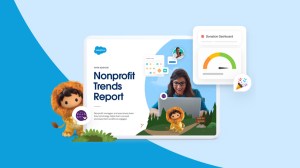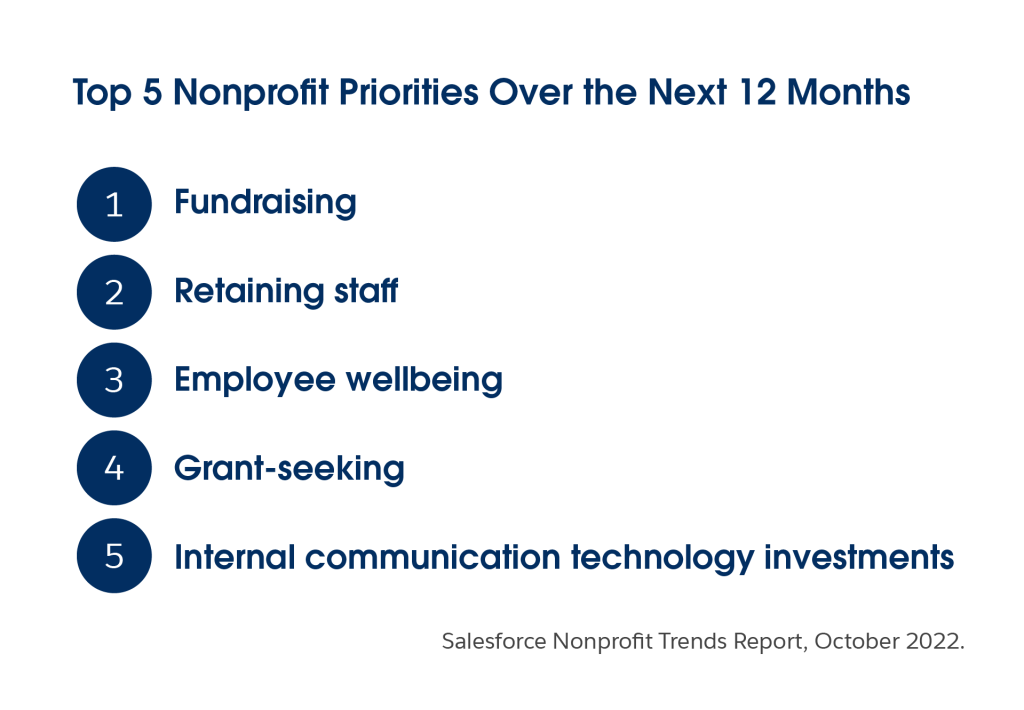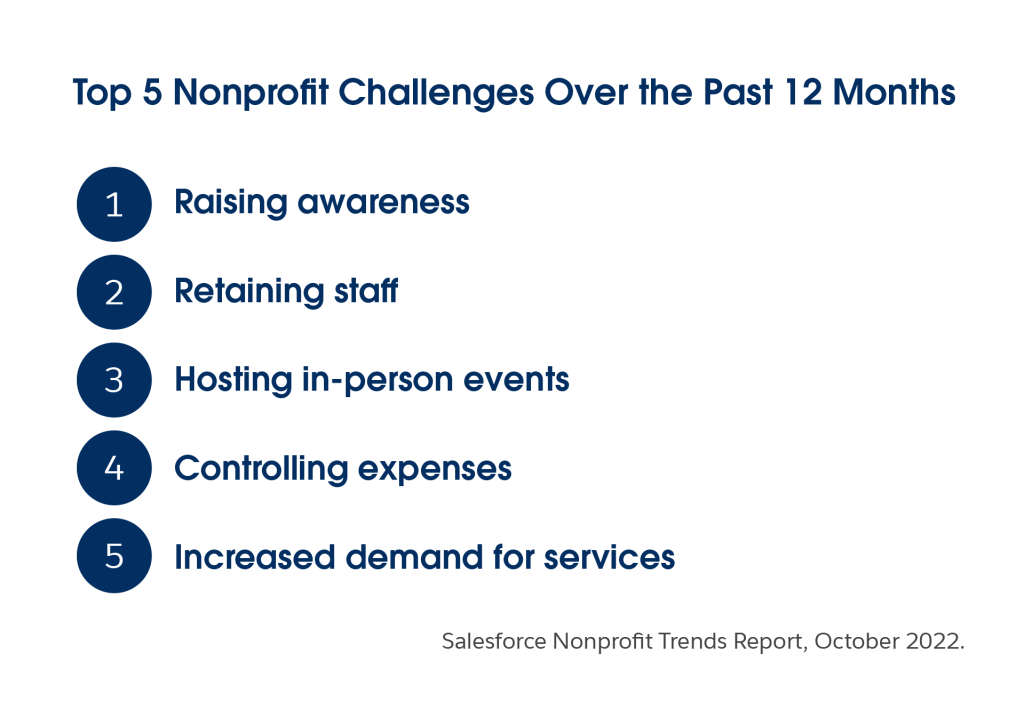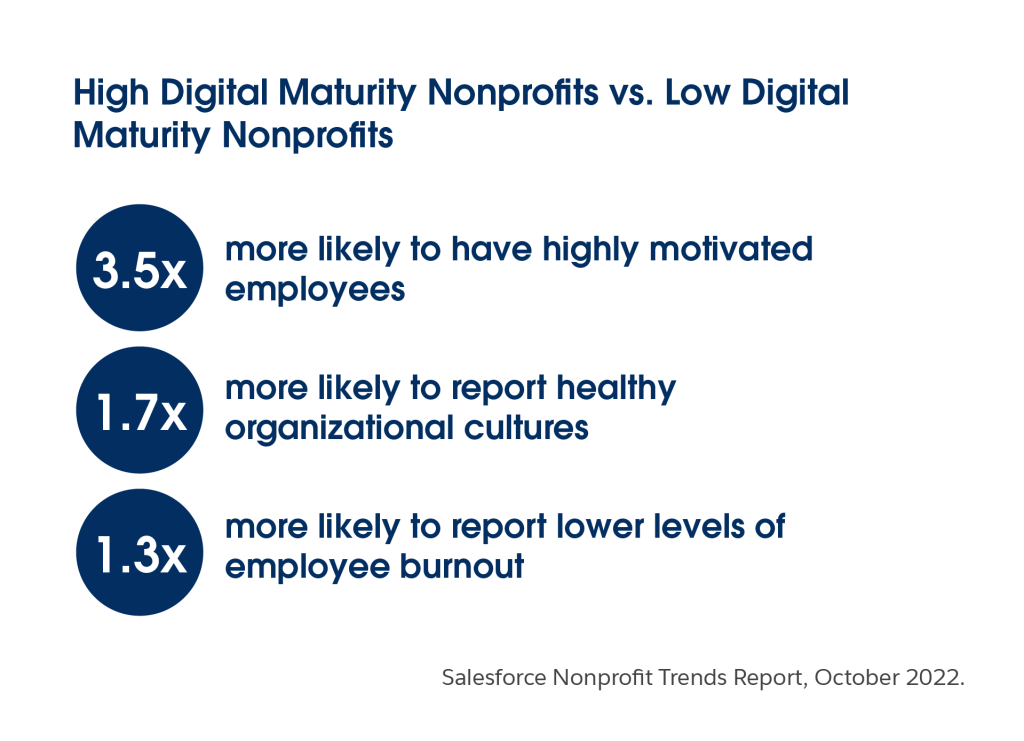Quick Take: Salesforce’s new Nonprofit Trends report uncovers how nonprofits are performing in the face of economic headwinds, an emerging employee retention crisis, and a transition to digitally-driven fundraising and operations. In addition, the report reveals how nonprofits are performing when it comes to diversity, equity, and inclusion (DEI) and sustainability.
Facing new technological and economic realities, nonprofits are adapting in many ways — and falling behind in others.
Digital transformation is taking center stage. Nearly three-quarters of those surveyed view digital transformation as essential. However, just one in eight said their organizations were mature in how they use technology to transform their organizations. And in a sector mired by burnout and high turnover, retaining staff was the second biggest issue nonprofits reported facing today.
To uncover the full breadth of challenges, priorities, and opportunities in the sector, Salesforce worked with independent research firm Reputation Leaders Ltd. to conduct a global survey — including 12 in-depth interviews with senior nonprofit leaders — of more than 1,600 nonprofit managers and executives across seven countries for the fifth edition of its Nonprofit Trends Report.
Here are a few highlights:
Retaining employees is a big issue for nonprofits
High employee turnover and a tight labor market has not spared the nonprofit sector. In the year ahead, employee retention will be a major priority for nonprofits – with almost half (46%) planning to prioritize retaining staff and boosting employee wellbeing (44%).
While retaining employees is a growing priority – and the most cited internal issue of the last year – professional development is not, representing a potential miss. Only 38% of nonprofits surveyed are making employee reskilling a higher priority. This is an issue as 92% of nonprofit employees surveyed in Salesforce’s Digital Skills Index said they do not have the workplace digital skills required for the jobs of the future.
Reskilling is a proven retention tool, and as the nonprofit sector becomes more technology-driven, skilling up employees will become an invaluable asset for organizations looking to retain employees and drive mission success.
“During times of economic uncertainty, fundraising is where nonprofits typically focus, but the true key to resilience is getting closer to the people who are the most invested in your mission – your staff,” said David Slater, VP, Salesforce for Nonprofits. “Not only does employee attrition come at a cost, but amidst a tight labor market and rising inflation putting pressure on wages, nonprofit leaders need to look at the employee experience now more than ever.”
DEI and sustainability fall by the wayside for many nonprofits
While corporations bring DEI into strategic focus to attract and retain talent, nonprofits have surprisingly been far less focused on it. Case in point: 40% went as far as to deem diversity and inclusion among employees, volunteers, and clients as “not an issue,” despite the historic lack of diversity on boards and among fundraising leaders at large nonprofits.
Fewer than half (40%) of organizations have taken DEI-related actions internally, and the most common action was to enable flexible or remote working arrangements. Only 32% of nonprofits say they interviewed diverse candidates for management positions. And an even smaller percentage – 28% – said they hired or promoted women and/or minorities into management roles in the last year.
Like DEI, sustainability was also not a focus for many nonprofits. Only 22% of organizations made “significant” progress in achieving sustainability targets. And nonprofits that do pursue sustainability initiatives focus on simple, near-term steps like reducing paper waste.
Nonprofits met or exceeded many of their top goals despite challenges, but are falling short in other key areas
Despite economic headwinds — like inflation, supply chain disruptions, and labor shortages — a vast majority of nonprofits reported meeting or exceeding their program, financial, and mission goals in the last 12 months.
While only 18% exceeded volunteering goals, half (50%) of nonprofits met these targets. Nearly a third (29%) did not meet their volunteering goals — a symptom of a volunteer shortage in many markets.
And, those that exceeded technology goals saw dividends. Such organizations were 30% more likely to have exceeded their mission goals, and 30% more likely to have surpassed volunteering goals.
Digitally mature nonprofits outperform their peers in unexpected ways
As demand for digital engagement grows, nonprofits with a high level of digital maturity are excelling. The Salesforce for Nonprofits Digital Maturity Index classifies their ability to use data to inform decision making, reach new audiences, personalize communications, and better forecast fundraising income.
These digitally mature organizations – only one-in-eight globally – outperform their peers regardless of their revenue, headcount, or geographic location. They are 4x more likely to achieve their mission goals and 2x more likely to see improvement in operational efficiencies.
Beyond operational performance, digitally-mature organizations excel culturally. These nonprofits are 3.5x more likely to have highly motivated employees. Employees of digitally mature organizations are also more optimistic about their workplace and report lower levels of burnout.
Nonprofits view technology as critical, yet few are satisfied with the technology they have
As nonprofits rethink remote work, and adapt to the rise in digital engagement, they are seeing the value of digital transformation. Nearly three-quarters – 74% – of those surveyed view digital transformation as essential.
Technology is also viewed as vital to nonprofit work. Three quarters (76%) of those surveyed say employees recognize technology as a critical part of their success. And 77% reported that technology helps them in other critical ways – like driving efficiency and improving mission impact – while 73% reported they rely on data to inform their decisions.
“Data isn’t just for reporting. It’s for making the critical decisions that improve the quality of programs and put relationships at the center,” says Brandi Adams, Vice President of Advancement at the Chinese American Service League.
Yet only 36% of nonprofit leaders admit they are “highly satisfied” with the technology that helps them do their jobs today, and less than half of those surveyed say they are actually able to make quick strategic decisions.
Meanwhile, 60% of nonprofits said their donors expect a better experience than their current technology provides. And, despite a common narrative that technology can detract from the human component of nonprofit missions, the data shows that digitally-mature organizations actually have stronger connections across all of their stakeholder groups.
Technology is the key to retaining employees, driving engagement, and boosting efficiency and fundraising
Nonprofits have proven their resiliency in the last year, but as economic headwinds deepen and rising inflation puts pressure on workers, nonprofits will need to do more to retain employees and drive their missions.
Technology is the key, helping nonprofits forge stronger stakeholder relationships, achieve their goals at higher rates, build a more motivated workforce, and make greater progress toward DEI and sustainability commitments.
Today, many nonprofits are behind the curve, but those who recognize the role technology plays in enabling innovation, collaboration, productivity, and wellbeing will be better positioned to thrive in the future economy.
More information
- Download the full 2022 Nonprofit Trends Report for more insights.
- Discover how Salesforce for Nonprofits helps build relationships that drive change.
- Read more insights into the digital skills crisis revealed by Salesforce’s Digital Skills Index.
Methodology
Data in the Nonprofit Trends Report, 5th edition is from an independently administered survey of 1,629 full-time nonprofit employees, holding a role of manager or higher, that took place between April 25 and June 17, 2022. Respondents were sourced through third-party panels and work at nonprofits in Australia, Canada, France, Germany, the Netherlands, the U.K., and the United States. Additionally, an independent research agency conducted 12 in-depth interviews with nonprofit employees at the director level and above in the same countries as mentioned above.





















